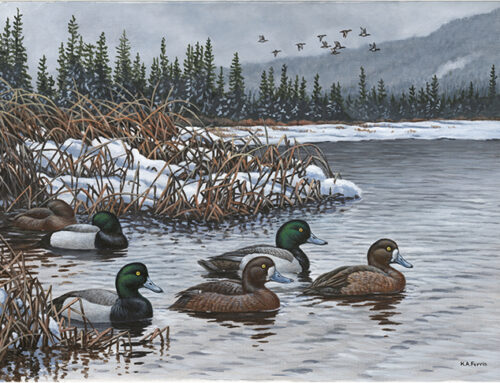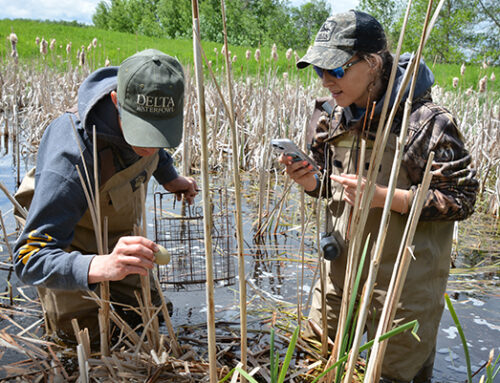Delta’s New Landmark: Produce 1 Million Ducks Annually
The Million Duck Campaign aims to maximize production and put more birds into every fall flight.

By Paul Wait
Whatever the number of ducks in the most massive flock you’ve ever encountered, it surely fell well short of a million. Even the famous 1956 photo of Claypool Reservoir in Arkansas—an incredible mass of mallards in flooded timber—only had a couple hundred thousand ducks in it.
Can you picture 1 million ducks? It’s almost unimaginable.
At Delta Waterfowl, we’re not only imagining it, we’re going to make it happen. Delta is launching the Million Duck Campaign, a transformative $250 million initiative to add 1 million ducks to the fall flight, year after year.
“The Million Duck Campaign is a monumental effort that’s unprecedented in waterfowl management,” said Dr. Scott Petrie, chief executive officer of Delta Waterfowl. “No one has ever achieved duck production on this scale. We’re going to produce 1 million more ducks every year, and it will increase the number of ducks in the fall migration in every flyway. That’s great for duck populations, and for duck hunters.”

A Changing Landscape for Ducks
There’s truth to the statement that “the only constant is that things are always changing.”
Waterfowl on the breeding grounds have experienced major shifts in habitat during the past 100 years, particularly in the prairie pothole region, a wetland-rich area that stretches from northern Iowa and western Minnesota, up through the Dakotas into Montana, and up into Manitoba, Saskatchewan and Alberta. The PPR is affectionately known as North America’s “Duck Factory” because a major portion—scientists estimate 50 percent or more during wet years—of the continent’s ducks hatch there.
“The PPR is hugely important to ducks,” said Dr. Frank Rohwer, president and chief scientist of Delta Waterfowl. “We know that duck populations are driven by what happens on the prairie breeding grounds, whether they successfully hatch a nest or not.”
Dotted with wetlands and temporary ponds, the PPR attracts millions of nesting ducks every spring. The PPR, with its rich soil and normally abundant moisture, also serves as a wonderful place to grow grain. While there’s room for waterfowl and agriculture, changes to the landscape such as wetland drainage and fragmentation of grassland acreage pose challenges for nesting ducks.
For the past 50 years, waterfowl conservation groups have done an admirable job of developing and championing programs to conserve critical breeding habitat through programs such as Delta’s Working Wetlands, Alternative Land Uses Services and GROW, provisions in the U.S. Farm Bill such as Swampbuster and the Conservation Reserve Program, and of course, funding from decades of Duck Stamp dollars. Certainly, Delta Waterfowl will always work with landowners, conservation partners and governments in a continuing effort to conserve as much breeding duck habitat as possible.
However, Delta recognizes that habitat conservation—while essential—is not enough to maintain duck populations at the levels most people desire.
The landscape has changed. Frightening numbers of small wetlands have been permanently drained, and grasslands that formerly provided nearly endless acres of nesting cover are now a patchwork of fragmented upland habitat. As the native prairie was settled and converted to farmland, another part of the equation changed for ducks: a new crop of critters, namely raccoons, skunks and a host of other mammalian predators moved into the agriculturally dominated landscape. Prior to the 1950s, raccoons were nonexistent on the prairies, and skunks were uncommon. Now, both are abundant throughout the PPR. Raccoons and skunks are opportunistic, efficient predators of duck nests. As habitat shrunk for breeding ducks, it became easier for these new prairie predators to find and destroy duck nests.
The result in some areas of the prairie has been devastating. Waterfowl managers point out that 15 to 20 percent nest success is required for ducks to simply maintain their populations. A number of studies have shown that in key areas of the PPR, nest success is abysmal, often less than 5 percent. When you factor in the number of hens killed by predators during the nesting season, we are actually losing ducks on many areas that attract high densities of breeding ducks—places with the potential to be among the best duck production habitat in North America.
“Predators play a very important role in the ecosystem. They always have and they always will. But a landscape altered by people has created an imbalance between waterfowl and predators,” said Joel Brice, chief conservation officer for Delta Waterfowl. “If one goal of securing habitat is to benefit duck production, then many of our landscapes and properties are falling short of that goal.”
Delta’s Million Duck Campaign aims to produce 1 million ducks every year, which we will accomplish by restoring the balance between predators and prey in key breeding habitat to maximize duck production.
Putting Delta’s Duck Production Programs to Work

Delta Waterfowl has a history of researching solutions to tough problems faced by ducks and duck hunters. The drought of the 1980s really brought into focus a couple of key problems ducks faced on the prairie. When waterfowl researchers—many of them Delta students—focused more projects on measuring nest success in the PPR, the impact of predation became clearer.
In 1991, Delta Waterfowl installed the organization’s first set of Hen Houses in Manitoba. Hen Houses are nesting tunnels lined with flax straw and positioned over water in semi-permanent wetlands. Mallards quickly adopted Delta’s nest structures as a safe place to nest out of reach of predators. Hatch rates in Hen Houses proved remarkably better than those of mallards nesting in the nearby grass. Student researchers, including Matt Chouinard, currently a waterfowl programs manager for Delta Waterfowl, helped refine the design and placement of Hen Houses. They’ve proved to be remarkably effective and efficient for mallard production, and Delta maintains nearly 10,000 Hen Houses across the PPR.
Hen Houses are favored by mallards, and the appeal of these nest structures is heightened because mallards are the most popular duck among hunters in North America.
“The areas where we can place Hen Houses across the PPR are almost limitless,” Brice said. “Hen Houses quietly produce ducks in the background, and they function beautifully on farms and ranches. It’s quite efficient.”
In 1994, Delta began to study Predator Management as a method to increase nest success of ducks on landscapes with less grass cover. By selectively removing predators immediately before and during the waterfowl breeding season, duck nest success skyrocketed. During the pilot study nest success on blocks without Predator Management showed 14 percent, while nest success on acreage where control was applied measured an astounding 71 percent.
“The first results were dramatic,” Rohwer said. “Those promising results prompted Delta to expand our studies of Predator Management as a real solution to the predator problem on the prairies.”
Delta tested Predator Management across several landscapes, and results have consistently shown great improvement in nest success across areas with fragmented and low percentage of grass cover. Today, Delta has 23 operational Predator Management sites in the PPR, along with three research locations.
“We are not trying to eliminate every predator, but we are trying to restore the balance between predator and prey,” Brice said. “We want to focus Predator Management on areas where the balance is misaligned.”
Backed by decades of research and operational program experience, Delta has shown that Predator Management and Hen Houses are efficient, cost-effective programs to produce ducks.
“We know how to produce ducks using Delta’s duck production tools,” Brice said. “If we apply Predator Management and Hen Houses in a complementary fashion, then we can achieve the duck production goal of habitat conservation.”
Applying Delta’s duck production programs to excellent habitat that’s not currently producing many successful nests will have an enormous impact for ducks and duck hunters.
“We can produce 1 million ducks by targeting less than 2 percent of the PPR with our duck production programs,” Rohwer said. “The contrast to wetland protection is dramatic: To maintain the habitat base, we need to protect everything, which is a far more daunting and expensive task. We know we will continue to lose wetlands, so the only way to maintain or increase duck numbers is to make the remaining habitat more productive—far more productive than it is right now.”
Embarking on the Challenge

The Million Duck Campaign is ambitious, for sure. Setting a $250 million fundraising campaign goal is bold.
Delta’s board and staff embraces the challenge. Given the strength, dedication and support shown by the donors, members and volunteers of The Duck Hunters Organization, Delta’s leaders are confident we can meet the goal of producing 1 million ducks, year after year.
“We work for duck hunters,” Brice said. “Our constituents are interested in duck production. The Million Duck Campaign is doubling down on our commitment to duck hunters. We’re giving our members and supporters an opportunity to contribute to the annual production of waterfowl.”
The Million Duck Campaign sets a $250 million fundraising goal, with $220 million as an endowment appropriated toward annual duck production programs. Annual earnings from the endowment fund will pay for Predator Management and Hen House program activities in perpetuity. The delivery goals call for about 751,000 of the million ducks per year to be produced by Predator Management, while the remaining 249,000 fledged ducks will be hatched in Hen Houses.
An additional $30 million of the campaign is slated for research and education, HunteR3, and habitat and hunting policy work.
While the primary focus of the Million Duck Campaign is duck production, Delta remains steadfast in its program delivery across all four of the organization’s pillars.
- Duck Production — Delta will strategically increase its annual duck production through Predator Management and Hen Houses to 1 million ducks annually.
- Habitat Conservation — Delta will continue to create programs and champion policies that conserve critical habitat for breeding ducks.
- Research and Education — Delta will pioneer waterfowl research to increase duck production and continue to inform waterfowl management decisions.
- HunteR3 — Delta will expand the organization’s work to recruit, retain and reactivate duck hunters through First Hunt and the University Hunting Program, while also Defending the Hunt anytime, anywhere as the “voice of the duck hunter.”
“All four pillars are critically important to Delta Waterfowl, and our complete approach to waterfowl and waterfowl hunting is what makes us The Duck Hunters Organization,” Petrie said. “The Million Duck Campaign will support and enhance all of Delta’s work.”
Scaling Up to Deliver
As chief conservation officer, Brice will manage delivery of the duck production goals set forth by the Million Duck Campaign.
What will it take for Delta to produce 1 million ducks annually?
“First and foremost, a successful fundraising campaign. After that, a lot of steel, wire and straw, and a bunch of well-trained people,” Brice said.
“The biggest thing we’re doing now is preparing to scale up the delivery,” he said. “We’re excited about the Million Duck Campaign. Our team of waterfowl biologists is ready to expand the impact of Delta’s work to produce more ducks.”
Much of the necessary work is sourcing materials for nest structures, building Hen Houses and distributing them. From there, the job turns into plotting and coordinating installation and annual maintenance of the structures.
On the Predator Management side, the effort entails identifying suitable sites, securing permission, and hiring and training predator control technicians.
Delta will also conduct ongoing research and evaluation to make certain Delta’s duck production tools are working effectively and efficiently.
All of it is work Delta has been doing for many years.
“I feel like everything it’s going to take to deliver duck production under the Million Duck Campaign is attainable,” Brice said. “It’s really a matter of logistics, scale and money.”
Let’s Make a Million Ducks
Delta Waterfowl is taking the lead for ducks and duck hunters in North America.
We know that waterfowl hunters want to see more ducks, and we acknowledge that current conservation efforts are not maximizing duck production in North America. We can do more with our conservation dollars.
“The majority of waterfowl conservation efforts are targeted at the future by saving habitat,” Rohwer said. “The Million Duck Campaign values annual duck production, which provides a way for hunters to contribute to ducks both for now and the future.”
Delta has a solid plan, as well as all of the proven science and programs to produce 1 million ducks annually with a fully funded Million Duck Campaign.
“When you’re out in a duck blind or laying in a field on a waterfowl hunt, so much of the enjoyment comes from seeing ducks,” Petrie said. “With the Million Duck Campaign, Delta Waterfowl is poised to lead waterfowl management into an exciting new era where we measure success by our contributions to the annual fall flight.”
For more information about the Million Duck Campaign and to learn how to contribute, visit deltawaterfowl.org.
Paul Wait is senior manager of communications for Delta Waterfowl.







Leave A Comment